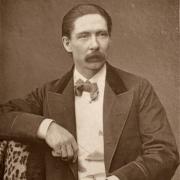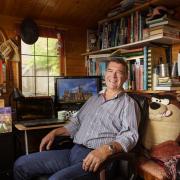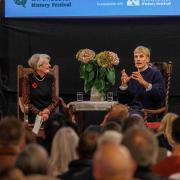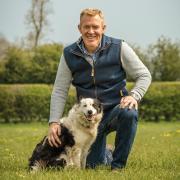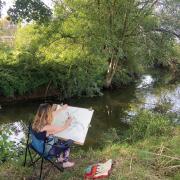Anselm Guise’s ancestral home, 13th-century Elmore Court and its estate, is being allowed to truly let its hair down at last, and he’s inviting us to experience some of the wildness with him
When Anselm Guise inherited the 1,000-acre estate Elmore Court from his uncle in 2007, he had the pressure of 750 years of family ownership behind him, and an estate in desperate need of some TLC.
‘I love it,’ Anselm Guise smiles, speaking of the ongoing rewilding of Elmore Court, ‘partly because you don’t have to do much; just let nature do its thing.’
He’s being playfully flippant, of course, as the knowledge and hard work that goes into operating a business in harmony with nature on this scale is immense.

Anselm inherited the 1,000-acre estate when his uncle passed away in 2007, with the responsibility of 750 continuous years of family ownership and a house that was beautiful but in need of considerable TLC (and money, lots of money). He moved in with his young family and proceeded to apply his creativity to clearing the debts and breathing fresh life into the family seat.
One of his early plans was to build a wedding venue that needed to be sustainable, soundproof and have the ability to bring in enough revenue to put the estate’s accounts back in the black. The resulting building was the incredibly successful ‘Gillyflower’ ballroom, constructed ten years ago of timber and rammed earth sourced from the estate grounds, which quickly became an incredibly popular place for couples across the country wanting to tie the knot and, importantly, a lucrative source of income. ‘It’s a wicked space,’ he enthuses.
Although the wedding business continues to thrive – bookings are filling up for 2025 – there are many estate employees relying on Anselm for a source of income, there’s land to be managed and a 13th-century family pile to protect, so he hasn’t rested on his laurels.


During his 16 years at Elmore, Anselm has restored the estate’s original walled gardens, reintroduced rare breeds onto the land, recreated wetlands on the site – working in collaboration with the Wildfowl and Wetlands Trust at nearby Slimbridge – and is now growing wheat in order to produce Elmore’s own flour. And rewilding at Elmore – which he has dubbed ‘Rewild Things’ – is at the heart of all that he’s doing.
‘There are lots of different opinions on rewilding,’ he continues, ‘but my view is that you should intervene as little as possible... and when you do intervene, you should try to do it in as close to a way that nature would. This means you have to think a little differently... and not put the needs of, for example, the bank in front of it!’
Easily said, you might think, but he really does have the courage and strength of character to see it through.

‘It’s the ‘thinking differently’ that becomes so interesting,’ he says; ‘it opens up a different way of seeing things. When you keep doing things over and over again, it feels kinda mad, but it’s a really beautiful process to be part of.’
Historic intervention on farmed land and the limits of space means, of course, that you can never be completely hands-off, though.
‘There are some things you can never really do,’ he explains. ‘For example, we have a herd of longhorn heifers that we’re breeding from, and so the bull needs to have his way. In a closed environment, if you had a bull and a load of girls, after a time the bull would be having sex with his daughters. In a big wilderness, the bull roams between herds and so that’s how it works.’

There are three main aspects to Rewild Things at Elmore: the magical treehouses; nature recovery; and regenerative farming and foods. Right now, a quarter of the 1,000-acre estate has been allowed to rewild but, as you’d expect, Anselm has plans to do much more.
‘There’s another farm on the estate that is coming back in hand in a couple of years’ time, and we’re deciding whether to extend the rewilding there, as it borders the existing land, or whether we should use it for regenerative farming. We’re currently running a pilot project, so if that’s a success we may continue on the other land, but my suspicion is we’ll do a hybrid of the two. Rewilding will be flanked by regen farming, which will be nice.’
Anselm has been working with old friend Andy Cato of Wildfarmed – using their regenerative farming processes – to farm in a sustainable way.


As well as founding Wildfarmed, Andy is one half of the electronic music duo Groove Armada, which took off stratospherically around 1996. This coincided with Anselm moving back to the land of his birth in South Africa, and so they lost contact for a while. ‘I went to the Southern Hemisphere, and he became a superstar,’ he laughs.
We talk about other environmental and questionable planning decisions that have been made locally, and you can sense his frustration when discussing issues such as building on floodplains and the amount of heat being produced by the colossal incinerator opened a few years ago, just off junction 12 of the M5. ‘The flip side of that,’ he continues in typically upbeat fashion, ‘is that on the whole we’ve been really supported with planning applications for what we’re doing here.’

Now onto one of the incredibly exciting projects Anselm has just completed on the estate at Elmore – a group of six sophisticated and sustainable treehouses built sympathetically in a wood on the estate that was originally planted as game cover, prompting one of his many dealings with local bureaucrats.
‘The woodland we built the treehouses in was compared to ancient woodland in an ecologist report – though it isn’t,’ he hastens to add. ‘Someone from Stroud District Council then said, “Oh, if it’s not ancient woodland, you need to prove that it isn’t.” Consequently, we had to find a map that was old enough to show when the woodland wasn’t there... and say, “There you go!’”
As a child, Elmore Court was owned by his uncle, but he remembers – with some fondness – spending time there.

‘Most of my memories are of being really cold,’ he laughs. ‘I have millions of cousins that came here a lot when my Uncle John was alive. I can remember having to sleep in the most weird places – such as the pulled-out drawer of a cupboard. Although this place is huge, there weren’t that many available bedrooms. Good memories... but always cold.’
Anselm is dead against imposing his views on others, and finds the idea of being judgemental ‘awful’, but he is buoyed up by the thought of playing some small part in people’s awakening to working in harmony with nature.
‘For me, this is what is so exciting about doing what we’re doing on the land. I love the idea of someone who hasn’t yet become aware of these issues, who doesn’t care, or has been brought up in such a way that it isn’t part of their reality, coming to stay in one of our treehouses and noticing that there’s something different about the environment they’re in. They may notice there are more birds, more bees, and think “hang on, this doesn't look like the English countryside I know,” and then want to find out why. If that tiny epiphany means in some way it changes their behaviour, and they go back to friends and family to share, then that’s really cool stuff. That’s the gold right there.’

The treehouses have been built within woodland, looking out over land that is being allowed to return to the wetland status it originally was, and forms part of the wider restoration of the Severn and Avon Vale floodplains. Of course, we’re aware that at the heart of the collection of six treehouses is Anselm’s desire to rewild the land, but you’ll find absolutely, positively no scrimping on luxury in these beautiful structures.
Arriving at the front door of Wren, Adder, Wild Cat, Sky, Earth and Kite – each name inspired by the South American medicine wheel (using British equivalent animals) – is an adventure in itself, with winding boardwalks carrying you through the foliage. When I visit, the tree canopy is lush, and a bed of bluebells carpets the land below; architects and builders have trodden lightly on the land so little recovery is required.
Each sustainably-constructed treehouse is unique – with Sky being pram/wheelchair-friendly – and clad in British cedar with corrugated roof, cork flooring and poplar ply walls. To take advantage of the great outdoors and that incredible view, the high-spec kitchen – and bathtub – is outside (though more modest bathers may be pleased to hear there’s a walk-in shower indoors, too). Seating and a brazier on the decking means you can gaze out onto the wetlands and listen to the sounds of the birds roosting well into the evening.

It matters hugely to Anselm that he supports the local economy, and employs many people from the surrounding towns and villages. He’s also keen to take advantage of talented family members, and so interior design is by his cousin Tracey Boyd, and the bespoke super king-size wooden spindle beds have been built by another cousin, Jamie Fraser.
The dream for Anselm is that his vision for rewilding and regenerative farming were to ‘bubble out’ and spread to other estates in the country and beyond. His positive outlook and persistence when things get difficult are an inspiration, and you can easily see many others following his lead.
‘If you’re surrounded by people who are doing good stuff, you’re much more likely to do it yourself,’ he says. ‘In yogic traditions, there’s a thing called sangha which is all about community; if you want to make things happen, then you align yourself with people who are similarly minded. My view is that everyone quite wants to be outside and to eat healthily, but sometimes they just don’t realise there’s an opportunity to do it.

After 750 years of family ownership, Elmore Court has struck gold with its current guardian. This corner of the Gloucestershire countryside has someone who cares deeply about Mother Nature, and who is quite happy to allow her to do her thing… with the gentlest of helping hands where necessary.
‘The things that we have here are genuine history – which is something that just cannot be purchased,’ he concludes, ‘and underpinning that all is our strong, sustainable ethos. I think when people come here, they see what we’re doing and thoroughly approve.’
Rewild Things at Elmore Court Estate, GL2 3NT: rewildthings.com
Treehouse bookings cost from £250 per night, with a minimum two-night stay.
Anselm Guise’s recommended read – Ravenous: Why Our Appetite Is Killing Us and the Planet, and What We Can Do About It, by Henry Dimbleby.









